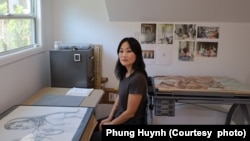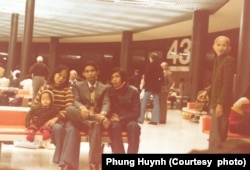While for many Californians pink donut boxes signal little more than the arrival of a favorite snack, for Cambodian refugees and their children, the ubiquitous, cheerful-looking packaging is often deeply intertwined with their family history of resettling in the United States.
So too, for Los Angeles-based artist Phung Huynh, whose parents were among the thousands of refugees who set up donut stores in California State since the early 1980s. They worked day and night to make a living in their new country, while struggling to overcome the memories of the war they fled.
Several years ago, Phung Huynh realized the bright pink packaging offered a highly symbolic and visually striking canvas for her drawings. The portraits depict her family and other members of Cambodian and Vietnamese communities in an effort to highlight their stories of hardship, trauma and resilience.
“The pink donut boxes seem to show sweetness and happiness. However, people who make those donuts are Cambodian refugees and immigrants who survived the [Khmer Rouge] genocide regime in their country. They went through suffering, pain, and family separation, and struggled to build a new life in America,” she told VOA Khmer in an interview.
‘Donut Kids’
Her art, she said, shows the travails of the Cambodian community in recent decades and brings their experiences to the attention of wider American society.
“I would like to make these pink donut boxes to represent so many stories. I don’t want people to forget all those stories,” Phung Huynh said.
Her most recent solo exhibition, called the “Donut (W)hole”, ran from March 12 to May 27 at Self Help Graphics & Art in East Lost Angeles. It featured seven hand-drawn portraits of Cambodian-Americans printed onto pink donut boxes, with their old family photos faded in the background.
They are second-generation “Donut Kids,” “who grew up in their family's donut shop. These donut shops represent a cultural space where refugees and immigrants reshape their lives in the process of negotiating, assimilating, and becoming American,” according to Phung Huynh’s personal website.
An earlier exhibit, from 2021, also featured a number of portraits of Cambodian- and Vietnamese-Americans drawn on plain pink donut boxes. These include drawings based on late-1970s photos of Phung Huynh as a toddler and her parents, as well as a contemporary portrait of acclaimed Vietnamese-American writer Viet Thanh Nguyen.
Promoting discussion and healing
In the late 1970s and 1980s, some 150,00 Cambodian refugees came to the U.S. to flee the Khmer Rouge regime and protracted civil war. They were dispersed by the government across the country, often in housing projects, and eventually formed sizable communities in places such as Chicago, Illinois, Long Beach, California, and Lowell, Massachusetts, and Seattle, Washington.
Equipped with limited formal education, many refugees struggled to overcome the traumas of war and to find a way to make a living. Opening up a donut store offered a stable, though demanding livelihood for many newly arrived Cambodians, who eventually came to dominate the donut business in California.
Phung Huynh’s father is from southern Cambodia’s Kampot Province and fled across the nearby border to Vietnam after Pol Pot’s forces took over the country around 1975. There, he met her mother and Phung Huynh was born in 1977. Soon after, her parents decided to flee by boat to the Cambodian refugee camps in Thailand, from where they were resettled to the U.S.
Art, she said, can help foster discussion of the difficult past and healing within Cambodian communities, as trauma is often not discussed by parents in order to avoid reliving past suffering or burdening the younger generation.
“I think such silence is detrimental for their children. What I can do is to help encourage those parents to explain their children about that,” she said.
“It is sometimes difficult to tell people about your feelings or reveal your own account, especially your miserable time, to others. Thus, art is one of the ways to reveal suffering and narrate many stories.”
Phung Huynh is a professor of Art at Los Angeles Valley College and her work includes drawing, painting, public art, and community engagement.
Some of her other work challenges beauty standards by constructing images of the Asian female body vis-à-vis plastic surgery to unpack how contemporary cosmetic surgery can whitewash cultural and racial identity, according to her website.










